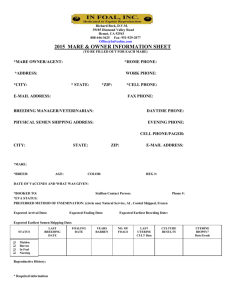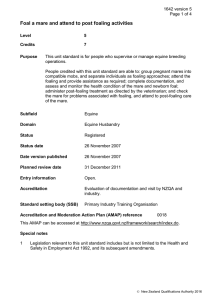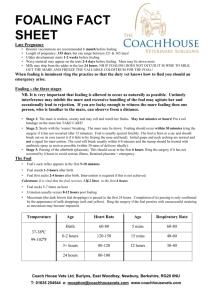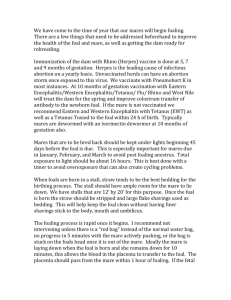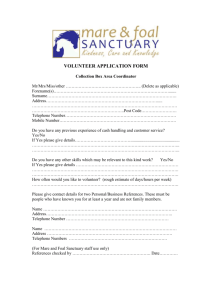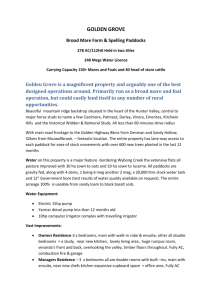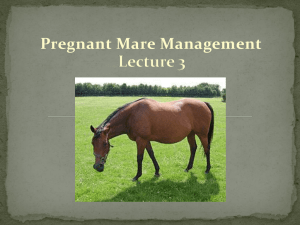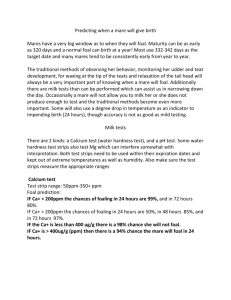Assist to foal a mare under supervision
advertisement
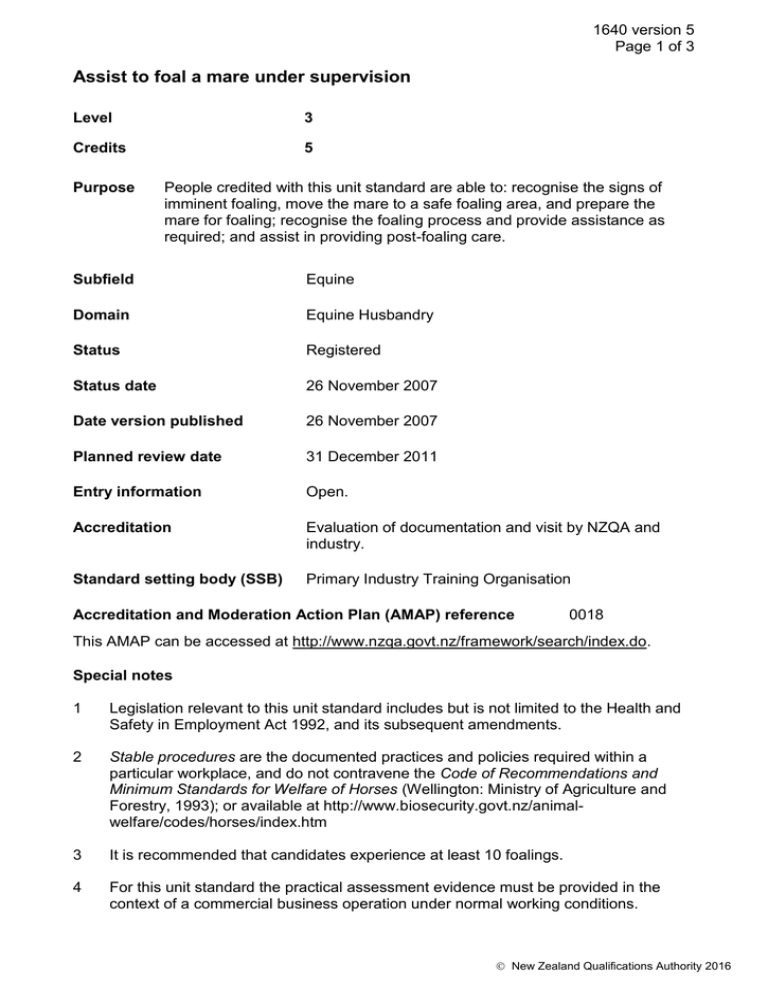
1640 version 5 Page 1 of 3 Assist to foal a mare under supervision Level 3 Credits 5 Purpose People credited with this unit standard are able to: recognise the signs of imminent foaling, move the mare to a safe foaling area, and prepare the mare for foaling; recognise the foaling process and provide assistance as required; and assist in providing post-foaling care. Subfield Equine Domain Equine Husbandry Status Registered Status date 26 November 2007 Date version published 26 November 2007 Planned review date 31 December 2011 Entry information Open. Accreditation Evaluation of documentation and visit by NZQA and industry. Standard setting body (SSB) Primary Industry Training Organisation Accreditation and Moderation Action Plan (AMAP) reference 0018 This AMAP can be accessed at http://www.nzqa.govt.nz/framework/search/index.do. Special notes 1 Legislation relevant to this unit standard includes but is not limited to the Health and Safety in Employment Act 1992, and its subsequent amendments. 2 Stable procedures are the documented practices and policies required within a particular workplace, and do not contravene the Code of Recommendations and Minimum Standards for Welfare of Horses (Wellington: Ministry of Agriculture and Forestry, 1993); or available at http://www.biosecurity.govt.nz/animalwelfare/codes/horses/index.htm 3 It is recommended that candidates experience at least 10 foalings. 4 For this unit standard the practical assessment evidence must be provided in the context of a commercial business operation under normal working conditions. New Zealand Qualifications Authority 2016 1640 version 5 Page 2 of 3 Elements and performance criteria Element 1 Recognise the signs of imminent foaling, move the mare to a safe foaling area, and prepare the mare for foaling. Performance criteria 1.1 The observable changes occurring in a mare in the days before foaling are identified. Range may include but is not limited to - change in behaviour, udder enlargement, waxing, mammary secretion, relaxed pelvic ligaments, hollow flanks, swollen vulval lips, sunken hindquarters. 1.2 Reasons for importance of mares foaling in individual paddocks under supervision are outlined in terms of possible foaling problems, and the mare is moved into a safe area in accordance with stable procedures. 1.3 Foaling alarm, if used, is checked to ensure it is operational, and is fitted to the mare's headcollar according to manufacturer’s instructions. Element 2 Recognise the foaling process and provide assistance as required. Performance criteria 2.1 Description identifies the normal duration, signs and course of events of stage one, two and three of foaling. 2.2 Mare is monitored, and assistance is provided in accordance with stable procedures. 2.3 Any ill health or abnormal course of events is reported and actioned in accordance with stable procedures. 2.4 Description identifies the importance of allowing the umbilical cord to constrict naturally. 2.5 Description identifies the importance of ‘checking the placenta’ in terms of retention and infection. 2.6 Records of the foaling process are maintained in accordance with property procedures. Range may include but is not limited to - time of events, problems, treatments, weight of membranes, colostrums levels in milk, sex and colour of foal, sire and dam. New Zealand Qualifications Authority 2016 1640 version 5 Page 3 of 3 Element 3 Assist in providing post-foaling care. Performance criteria 3.1 Foal is held in a manner that restrains but causes minimum stress to the foal. 3.2 The importance of colostrum is described in terms of time frame of the foal’s first drink. Range 3.3 quality, amount. Description identifies the observable signs of the foal retaining meconium and outlines possible course of action. Please note Providers must be accredited by NZQA, or an inter-institutional body with delegated authority for quality assurance, before they can report credits from assessment against unit standards or deliver courses of study leading to that assessment. Industry Training Organisations must be accredited by NZQA before they can register credits from assessment against unit standards. Accredited providers and Industry Training Organisations assessing against unit standards must engage with the moderation system that applies to those standards. Accreditation requirements and an outline of the moderation system that applies to this standard are outlined in the Accreditation and Moderation Action Plan (AMAP). The AMAP also includes useful information about special requirements for organisations wishing to develop education and training programmes, such as minimum qualifications for tutors and assessors, and special resource requirements. Comments on this unit standard Please contact the Primary Industry Training Organisation standards@primaryito.ac.nz if you wish to suggest changes to the content of this unit standard. New Zealand Qualifications Authority 2016
